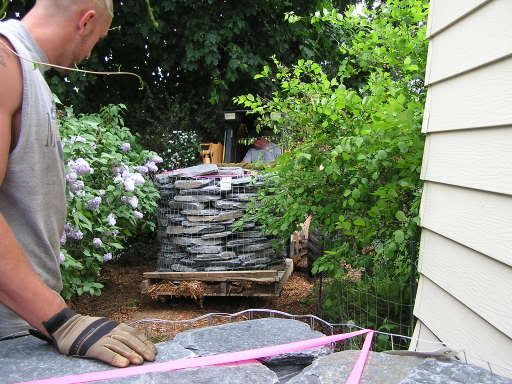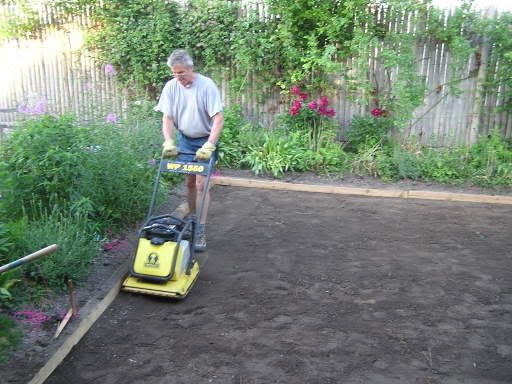I've been reading everything I can find here on laying a flagstone patio the last few days, only to discover that what I have been calling flagstone, you all call "crazy paving." (!)
A new search on crazy paving has left me a bit discouraged and with more than a few questions. I think I've read all the archives and new posts and web pages dealing with this, but since I am in Montana, USA, and, since I have a different idea about what I want to do than what you generally advise, I hope you can help before I make a royal mess.
I am now ready to lay the rock on a sand base, but I am utterly confused about how to lay this rock to get the effect I want, even though I've read and read and read!
I'll try to give you enough background to be useful without running on too long. Thanks in advance for your time and help!!
I have acquired four tons of local, native blue flagstone (what we call flagstone here), with thicknesses from 1 1/2" to 2 1/2" (40 to 60 cm) and very irregular in shape and size. My garden is rather wild, and so I wanted the native stone for a certain effect: widely spaced natural rock, with lots of interesting plantings and creepers in between, mosses and thymes, etc.
here is a picture of the actual palettes of the rock:

We've excavated an 18' x 16' area down 4", or in British English: it's about 5 1/2 m x 5 m. down 10 cm. (I hope I got my math right, I'm reading out of a conversion table in the dictionary). The patio is adjacent to the back porch, so we graded it (the fall) down one inch (2.54 cm) per every 8 feet (2 1/2 m).
We compacted the soil, put in a surround of 4x4 cedar posts to hold the sand, laid down high quality weed fabric, and have filled the area with contractor's sand, or sharp sand.
Here's a couple of pictures that give an idea of the scope of the project:

That's me on the mini-bobcat we rented. the soil was very hard and compacted, so we needed this tool.

That's my husband compacting the bottom, which we leveled out and graded very nicely, I think.
So now it is full of sand, and I'm not sure what to do next.
I gather from reading your website that:
1. Crazy pavers are very difficult to lay well.
I have never done this before. We are complete DIYers and all planning has been done from reading and learning. I want to lay these well, and I want it to be beautiful and to last. If I could become a hotdogger on that bobcat in one day, I bet I can climb up the steep crazy paver learning curve, too.
2. Crazy pavers should be butted up closely to each other.
We only bought enough rock to space them very widely, and frankly, that is the look we want. We don't want a continuous hardscape. We want pavers interspersed with creeping plants. In the areas where we are putting our table and chairs, and our chaise, and our travel paths and hard use areas (like off the back porch) I plan to put the largest rocks, closer together, but the other areas the rocks will be more sparsely placed. I have drawn out a diagram for this on graph paper.
3. Crazy pavers need to be individually bedded.
OK, here is where I need some clarity: How do I know how much sand to put in if I am not tamping or screeding? (I'm not supposed to tamp or screed, right?) Do I just throw in the sand, rake it around, and then individually set each paver to the height of a drawn string? If I do that, then how will the rocks ever be firmly set in the sand?
Would it help to soak the sand with a sprinkler for an hour or so and leave it to consolidate on its own overnight? Or would that firm it up too much?
What I had planned to do was fill the bed entirely with sand (the bed is 3 1/2" deep), tamp down with a hand tamper, then screed to 1 3/4" deep, then lay all the rock at once, arranging artistically, then go back and adjust the heights of the rock. I take it that will not be a successful approach?
If I did tamp and screed, should the sand be screeded down to the level of the thickest rock, i.e. 2 1/2", and then all the other rocks raised up to meet the topline?
Is just plain sand not going to work? I see you mix in a little cement. I am in Montana, where it gets very cold, and it is a very dry climate (single digit humidity outside, often). I would think that any kind of mortar for crazy paving would be ill advised in this climate. The rocks, I would think, would need the flexibility to shift with the soil temperatures. Can you comment? And if I did use the cement, would that keep me from doing my plantings?
I had planned to fill in with a sand/dirt/compost mixture for the plants. Would that help more to set the stones firmly?
What kind of fill would be best? Some of these stones may be six inches to a foot apart (15 to 30 cm).
I'm holding off on laying the stones until I hear from you. I do not want to make a mess of this. We already have too much time, love, and effort, not to mention money, invested to bollux it up now.
Can you advise me as to the most efficient, stable, and lasting method to achieve the effect and use I am after?
Many thanks in advance, and apologies for the long post.
